Chlor-Alkali Market Overview:
The global chlor-alkali market is witnessing stable growth, driven by increasing demand from industries such as chemicals, water treatment, paper & pulp, textiles, and pharmaceuticals. This market encompasses key products such as chlorine, caustic soda, and soda ash. Our report provides an in-depth analysis of procurement trends, focusing on cost reduction strategies and the adoption of digital solutions to enhance procurement and manufacturing processes.
The main future challenges in procurement include managing price fluctuations of raw materials, ensuring consistent supply chain operations, and addressing environmental sustainability demands. Digital procurement tools and strategic sourcing practices are essential for optimizing the chlor-alkali supply chain and ensuring long-term business competitiveness. As global demand continues to rise, companies are utilizing market intelligence to boost operational efficiency and mitigate risks.
The chlor-alkali market is expected to grow steadily through 2032, with key projections as follows:
- Market Size: The global chlor-alkali market is estimated to reach USD 95.37 billion by 2032, growing at a CAGR of around 4.2 % from 2024 to 2032.
Growth Rate: 4.2%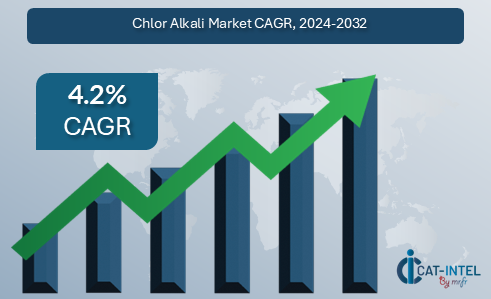
- Sector Contributions: Growth in the market is driven by:
- Chemical Industry Growth: Rising demand for chlorine and caustic soda in chemical production processes, such as the manufacturing of PVC and other industrial chemicals.
- Water Treatment Needs: Increasing demand for chlorine in water and wastewater treatment, particularly in emerging markets focusing on improving public health infrastructure.
- Technological Transformation and Innovations: Advancements in chlor-alkali technologies, such as membrane cell technology, are improving efficiency and reducing environmental impact.
- Investment Initiatives: Companies are investing in modernized production facilities and advanced electrolysis technologies to increase production efficiency and lower operational costs.
- Regional Insights: The Asia-Pacific region remains a dominant player due to its large chemical industry base and growing urbanization, driving demand for chlor-alkali products, particularly in water treatment and manufacturing applications.
Key Trends and Sustainability Outlook:
- Digital Integration: Automation and digital tools in chlor-alkali production are optimizing operations, reducing downtime, and enhancing process control.
- Environmentally Friendly Innovations: Companies are increasingly adopting sustainable practices by reducing carbon footprints and exploring green chemistry alternatives for production.
- Customization Trends: Growing demand for specialized chlor-alkali products, such as high-purity caustic soda and chlorine for niche applications.
- Data-Driven Production: Utilizing big data and analytics to improve production efficiency, track real-time performance, and enhance quality assurance processes.
Growth Drivers:
- Chemical Production: Continuous growth in the chemical sector, particularly in PVC, is driving the demand for chlorine and caustic soda.
- Water Treatment Demand: Increasing focus on safe drinking water and wastewater management is fuelling demand for chlorine and caustic soda in water treatment.
- Regulatory Compliance: Stringent environmental and safety standards in chemical and water treatment industries are influencing the demand for high-quality chlor-alkali products.
- Sustainability Trends: Companies are increasingly investing in eco-friendly production techniques and renewable energy sources to align with global sustainability targets.
- Customization Needs: Rising demand for tailor-made chlor-alkali products, especially in specialized sectors like textiles and pharmaceuticals.
Overview of Market Intelligence Services for the Chlor-Alkali Market:
Recent market analyses have emphasized key challenges such as fluctuating raw material prices and the complexity of maintaining sustainable production. Market intelligence reports offer valuable insights into procurement opportunities, helping businesses identify cost-reduction strategies, optimize supplier relationships, and improve supply chain resilience. These reports also aid organizations in maintaining compliance and high-quality standards while managing costs effectively.
Procurement Intelligence for Chlor-Alkali: Category Management and Strategic Sourcing:
To stay competitive in the chlor-alkali market, companies are streamlining procurement processes by conducting spend analysis for vendor monitoring and improving supply chain efficiency through market intelligence. Effective category management and strategic sourcing are crucial for minimizing procurement costs and ensuring a consistent supply of high-quality chlor-alkali products. By leveraging market intelligence, businesses can refine their procurement strategies and negotiate the best terms for their chlor-alkali requirements.
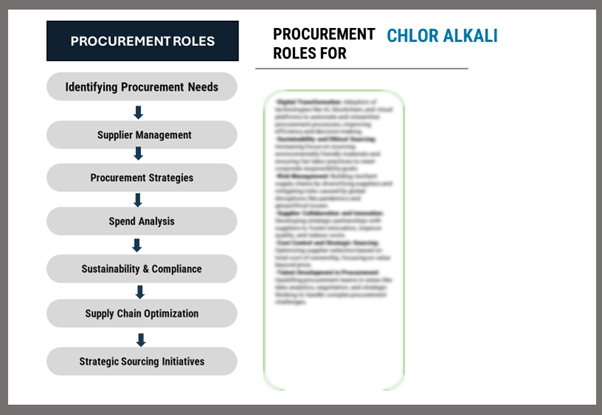
Pricing Outlook for Chlor-Alkali: Spend Analysis
The pricing outlook for chlor-alkali chemicals is expected to remain relatively stable, although fluctuations in prices may occur due to various influencing factors. Changes in the cost of key raw materials, such as salt, energy, and other inputs used in the electrolysis process, are significant drivers of price trends. Additionally, growing demand for high-purity, sustainable, and customized chlor-alkali products is exerting upward pressure on prices.
Graph shows general upward trend pricing for chlor alkali and growing demand. However, there may be fluctuations influenced by economic conditions, technological advancements, and competitive dynamic.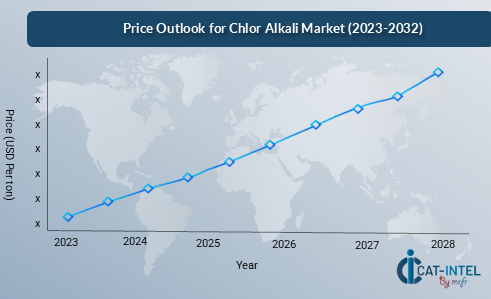
Efforts to improve manufacturing efficiency, reduce energy consumption, and adopt advanced technologies, such as energy-efficient electrolysis cells and process optimization systems, are crucial for managing costs. The development of more sustainable production methods and the use of renewable energy can help mitigate price increases.
Collaborating with responsible suppliers, adhering to fair trade practices, and improving supply chain logistics are vital strategies for managing costs. Despite these challenges, maintaining strong quality control, compliance with environmental regulations, and investing in research and development will be key to controlling pricing effectively.
Cost Breakdown for Chlor-Alkali: Total Cost of Ownership (TCO) and Cost-Saving Opportunities
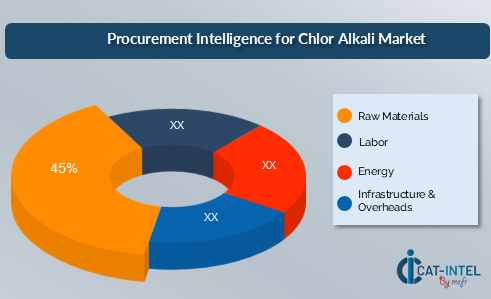
- Raw Materials (45%)
- Description: Raw materials include salt, water, and other chemicals used in the electrolysis process, as well as packaging materials. These materials must meet high-quality standards to ensure the efficiency and safety of the end products.
- Trends: There is a growing demand for eco-friendly and high-performance chemicals, which is influencing procurement practices. Suppliers are increasingly implementing sustainable sourcing methods to align with environmental regulations and enhance product quality.
- Labor (XX%)
- Energy (XX%)
- Infrastructure & Overheads (XX%)
Cost-Saving Opportunities: Negotiation Lever and Purchasing Negotiation Strategies
In the chlor-alkali industry, optimizing procurement processes and improving manufacturing methods can result in significant cost reductions and operational efficiencies. Building long-term relationships with raw material suppliers, particularly for essential inputs like salt, energy, and chemicals, can lead to bulk purchasing discounts, lowering the cost per unit. Strategic partnerships with production facilities can offer financial benefits through better payment terms and improved operational efficiencies. Investing in advanced technologies, such as energy-efficient electrolysis systems and automated quality control, can help reduce energy consumption, enhance production precision, and minimize waste. Furthermore, adopting sustainable production methods and sourcing eco-friendly chemicals can lower operational costs while meeting growing environmental regulations. Employing multi-sourcing strategies also helps mitigate risks associated with supply chain disruptions and strengthens negotiating leverage with suppliers.
Supply and Demand Overview for Chlor-Alkali: Demand-Supply Dynamics and Buyer Intelligence for Effective Supplier Relationship Management (SRM)
The chlor-alkali market is experiencing steady growth, driven by rising demand from sectors like chemicals, water treatment, and manufacturing. The balance between supply and demand is influenced by factors such as technological advancements, regulatory changes, and global market dynamics.
Demand Factors:
- Expansion of Chemical and Industrial Applications: Increasing investments in industries like chemicals, textiles, and pharmaceuticals are driving the need for chlor-alkali products, particularly for applications requiring chlorine and caustic soda.
- Water Treatment Growth: The demand for chlorine in water and wastewater treatment is rising, driven by urbanization and improved public health initiatives, particularly in developing regions.
- Regulatory Standards: Stringent safety and environmental regulations are increasing the demand for certified, high-quality chlor-alkali products across industries.
- Customization and Specialty Products: The increasing demand for specialized chlor-alkali solutions, such as high-purity caustic soda and chlorine for specific applications, is shaping market trends.
Supply Factors:
- Raw Material Availability: The availability of key raw materials, such as salt and energy, plays a critical role in the production of chlor-alkali products and is influenced by market fluctuations and supply chain issues.
- Technological Advancements: Innovations in production processes, such as energy-efficient electrolysis and automated quality control, are enhancing supply efficiency and product quality.
- Skilled Workforce Availability: A skilled workforce is essential for maintaining production consistency and ensuring high-quality standards in chlor-alkali manufacturing.
- Supplier Competition: Strong competition among chlor-alkali suppliers is leading to better product quality and more competitive pricing, benefiting buyers by providing access to high-quality materials at favourable rates
Regional Demand-Supply Outlook: Chlor-Alkali
The Image shows growing demand for chlor alkali in both Asia Pacific and North America, with potential price increases and increased Competition.
Asia-Pacific: Dominance in Chlor-Alkali Chemicals Market
The Asia-Pacific region, especially countries like China, India, and Japan, plays a dominant role in the global chlor-alkali chemicals market, driven by several key factors:
- Major Production Hubs: The region is home to some of the largest manufacturers of chlor-alkali chemicals, supported by favourable industrial policies and vast production infrastructure.
- Advanced Manufacturing Capabilities: Asia-Pacific benefits from highly advanced manufacturing facilities that utilize cutting-edge technologies for producing chlor-alkali products.
- Cost-Effective Labor and Production: The availability of cost-effective labor and lower operational costs in key producing countries provides Asia-Pacific with a competitive edge in offering affordable chlor-alkali chemicals to global markets.
- Export Leadership and Global Reach: Countries such as China and India are major exporters of chlor-alkali chemicals, supplying a wide range of products to markets in North America, Europe, and other regions with strong demand for these essential chemicals.
- Focus on Quality and Sustainability: Producers in the region are increasingly adopting sustainable practices and implementing advanced quality control measures to meet international regulatory standards and address the growing demand for eco-friendly and high-performance chlor-alkali products.
Asia Pacific Remains a key hub chlor alkali price drivers Innovation and Growth.
Supplier Landscape: Supplier Negotiations and Strategies
The supplier landscape in the chlor-alkali chemicals market is dynamic, with both global and regional suppliers playing crucial roles in driving industry growth. These suppliers significantly influence key market factors, including pricing, product quality, and supply chain efficiency. The market is competitive, with large, multinational suppliers dominating global trade, while smaller, specialized companies focus on niche markets, offering customized and high-purity chlor-alkali products for specific industries.
The supplier landscape, especially in key production regions, is vibrant, with a mix of established players and emerging suppliers addressing both global and local demand. As the need for advanced and sustainable chlor-alkali chemicals increases, suppliers are focusing more on innovation, sustainable practices, and strategic collaborations to enhance their market position and meet the rising demand for high-quality and environmentally friendly products.
Key Suppliers in the Chlor-Alkali Market Include:
- Dow Chemical Company
- Occidental Petroleum Corporation
- AkzoNobel
- Formosa Plastics Corporation
- Tata Chemicals
- Covestro
- Shin-Etsu Chemical Co., Ltd.
- Solvay
- Ercros S.A.
- Tata Chemicals
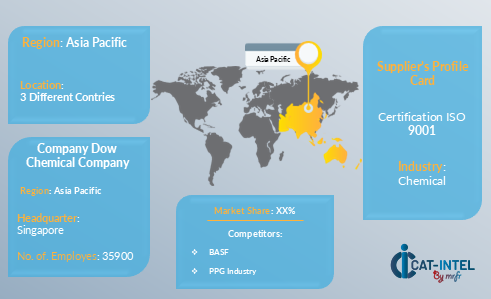
Key Developments Procurement Category Significant Development:
|
Significant Development |
Description |
|
Market Growth |
The global chlor-alkali chemicals market is experiencing growth, fueled by increasing demand from industries such as chemicals, water treatment, and manufacturing. |
|
Sustainable Practices |
There is a growing focus on sustainable production methods and eco-friendly chemical solutions to comply with environmental regulations and cater to consumer demand for greener products. |
|
Product Diversification |
The market is seeing an expansion of chlor-alkali product offerings, including specialized products for specific applications such as high-purity caustic soda and chlorine for various industrial needs. |
|
Technological Innovations |
Advanced technologies, such as energy-efficient electrolysis and automated quality control systems, are being adopted to improve production efficiency, reduce energy consumption, and enhance product quality. |
|
E-commerce Expansion |
The rise of digital platforms for the sale of chlor-alkali chemicals is broadening market reach, enabling suppliers to access global markets and better cater to bulk customer requirements. |
|
Focus on Miniaturization |
There is an increasing demand for more compact and efficient chemical solutions, such as concentrated products and smaller packaging, to meet specific needs and minimize waste. |
|
Chlor-Alkali Attribute/Metric |
Details |
|
Market Sizing |
The global chlor-alkali market is estimated to reach USD 95.37 billion by 2032, growing at a CAGR of around 4.2 % from 2024 to 2032. |
|
Chlor-Alkali Chemicals Technology Adoption Rate |
Around 45% of companies in the chlor-alkali chemicals industry are adopting advanced technologies, such as energy-efficient electrolysis and automated quality control systems, to enhance production and reduce energy consumption. |
|
Top Chlor-Alkali Chemicals Strategies for 2024 |
Key strategies include investing in sustainable production methods, expanding product offerings for specialized applications, enhancing supply chain efficiency, and adhering to stricter environmental regulations. |
|
Chlor-Alkali Chemicals Process Automation |
Approximately 35% of companies in the chlor-alkali chemicals industry have automated key production processes, such as chemical production, packaging, and quality control, to increase efficiency and ensure consistent product quality. |
|
Chlor-Alkali Chemicals Process Challenges |
Major challenges include rising energy costs, managing raw material availability, adhering to environmental regulations, and ensuring product quality while scaling production. |
|
Key Suppliers |
Leading suppliers in the chlor-alkali chemicals market include Dow Chemical Company, Occidental Petroleum, and AkzoNobel, offering a range of products for applications across industries such as water treatment, manufacturing, and chemicals. |
|
Key Regions Covered |
Key regions in the chlor-alkali chemicals market include North America, Europe, and Asia-Pacific, driven by demand from industries like water treatment, chemicals, and manufacturing. |
|
Market Drivers and Trends |
Growth is driven by the increasing need for chlorine and caustic soda in various industrial applications, the focus on sustainable practices, and advancements in electrolysis technologies that improve production efficiency. |
Frequently Asked Questions (FAQ):
Our procurement intelligence services provide detailed insights into the chlor-alkali chemicals supplier market, identifying key manufacturers and analysing market trends. We offer spend analysis, supplier assessments, and sourcing strategies to ensure you procure high-quality chlor-alkali chemicals at competitive prices.
We help evaluate the TCO for chlor-alkali chemicals by factoring in raw material costs, production, energy expenses, transportation, and storage. Our comprehensive cost analysis ensures you understand the full financial impact of your procurement decisions.
We provide risk management solutions to address challenges such as price volatility in raw materials, supply chain disruptions, and supplier reliability. These strategies ensure a stable supply of chlor-alkali chemicals while maintaining quality and performance.
Our Supplier Relationship Management (SRM) services focus on fostering long-term, mutually beneficial partnerships with chlor-alkali chemicals suppliers. We assist in contract negotiations, supplier performance monitoring, and quality assurance to ensure consistent supply at favourable terms.
We recommend procurement best practices, such as supplier segmentation, cost-benefit analysis, effective inventory management, and performance monitoring. These practices help streamline the sourcing process and ensure cost-efficient procurement of chlor-alkali chemicals.
Digital tools enhance chlor-alkali chemical procurement by automating processes and providing real-time insights. Data-driven platforms assist in tracking supplier performance, optimizing inventory, and streamlining procurement workflows for improved efficiency.
Our supplier performance management services focus on monitoring critical metrics such as product quality, delivery times, and compliance with specifications. This ensures suppliers meet expectations and guides future procurement strategies.
We support negotiation strategies by offering market intelligence, supplier pricing benchmarks, and leveraging volume-based discounts or long-term contracts. These strategies help you negotiate better terms and secure greater value in chlor-alkali chemical procurement.
We provide market analysis tools offering insights into price trends, supplier performance, and demand forecasts. These tools empower you to make informed, data-driven procurement decisions in the chlor-alkali chemicals market.
We guide you through regulatory and industry compliance requirements, ensuring your suppliers meet quality standards, safety regulations, and sustainability practices. This includes verifying certifications and ensuring adherence to environmental and regulatory guidelines.
We offer strategies to mitigate supply chain disruptions, such as diversifying suppliers, creating contingency plans, and identifying backup sources. These strategies help ensure a continuous supply of chlor-alkali chemicals despite unforeseen challenges.
Our performance tracking solutions monitor key metrics like delivery accuracy, product quality, and compliance. This helps you assess supplier performance and make better procurement decisions moving forward.
We help identify suppliers with sustainable practices, such as eco-friendly manufacturing processes, waste reduction, and ethical sourcing. This ensures your chlor-alkali chemical procurement aligns with sustainability goals.
Our pricing analysis services compare costs across suppliers, track market trends, and apply negotiation strategies to secure the best pricing for chlor-alkali chemicals while maintaining high product quality and performance.








